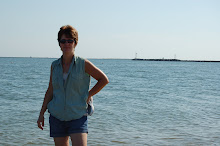
Several years ago I was asked to fill a vacant space on the Calvary Cemetery Board of Directors (in one of those drily humorous twists of fate that you gotta love, the seat was vacant because the previous board member had - you guessed it - died. How eminently logical and wierdly appropriate....) Up until then I had no idea there was such a board, although I was dimly aware of the existence of the mysterious old graveyard behind a vintage iron fence on Clark Street a few blocks from Holy Trinity Church.
On the Sunday afternoon in March that I attended my first annual board meeting, I decided to take a walk through the cemetery. As I passed under the arch that displayed the name “Calvary” the quiet enveloped me. The traffic from the neighboring streets seemed muted. I began to read tombstones and get acquainted with those whom I felt, as a board member, had become my charges.
Calvary Cemetery was founded in the 1850’s during the pastorate of Fr. Jeremiah O’ Conner. Originally known as Holy Trinity Cemetery, it was the burial place for many of the Irish immigrants who settled in the area west of Clark Street known as “Little Dublin, ” now the site of Trinity Place apartments. Their presence is reflected in the many tombstones inscribed with Irish names: Mahoney, McNary, Sheehan, Flynn, Mulligan, O’Brian, Dillon, Kelly. Some of them speak to us. “It is therefore a holy and wholesome thought to pray for the dead, that they may be loosed from sins,” James Ryan (died March 15, 1862) reminds us, with a quote from the Apocrypha, on his monument. They hoped we would keep them in our thoughts long after their passing.
Parishioners from neighboring St. John the Baptist Parish, and later, St. Mary’s, many of them immigrants from Italy and central and eastern Europe, also found their final resting place at Calvary Cemetery. Their names add a cosmopolitan flavor to the cemetery roll: Scarpa, Earnst, Habig, Lafayette, Neiderlander, Opavsky.
Many of the names are familiar to me: I rub elbows with their descendents every weekend at Mass. Others bring back childhood memories: beloved priests including Reverend John Oberlander, pastor of St. John’s when I attended grade school there. I can remember his funeral, grand and solemn in a standing-room-only, incense-scented church, but most times when I see his tombstone on my cemetery ambles, I remember how he could descend from the pulpit after delivering a high volume, hair -raising sermon on the perils of sin, then come out to the playground and jump rope with us school kids.
Over 2000 people have been buried in the cemetery since its founding. Early records are sparse and unfortunately many were destroyed, along with some of the tombstones, during the 1913 flood that swept away much of the area’s history. An early trustees report which survives, dated 1908, notes that a Mr. William Barry was responsible for maintaining the grounds in “a very well-kept condition” and adds that “rigid economy had to be exercised so as not to exceed our income” (so what else is new?). It too contained many familiar names of dues-paying members including – to my surprise – my grandfather , who died long before I was born – Frank Burk.
This same 1908 report notes that “surely Catholics want their Cemetery to be a credit to them, and all should evince the right kind of spirit and show the proper interest in bringing this about.” Some things never change and yes, a hundred and two years later, the same sentiment might be expressed along with its logical conclusion – a request for contributions to help maintain this cemetery which contains so much of our history as a parish. There are no remaining open lots for sale, but we still have yearly expenses to address, including maintenance and insurance. Virtually our only income, apart from a few burials a year, is our annual collection. We hope you will be kind enough to contribute to this treasured part of our parish history, and perhaps make some time for a quiet stroll on the old gravel paths. What memories will you uncover?

